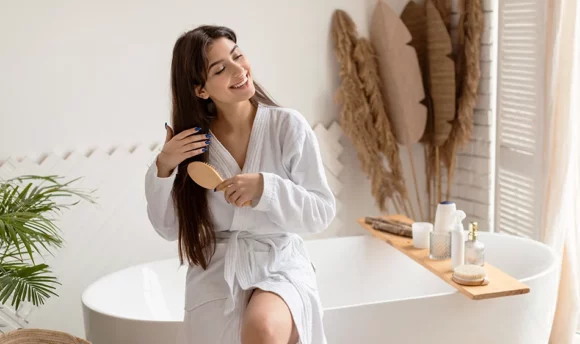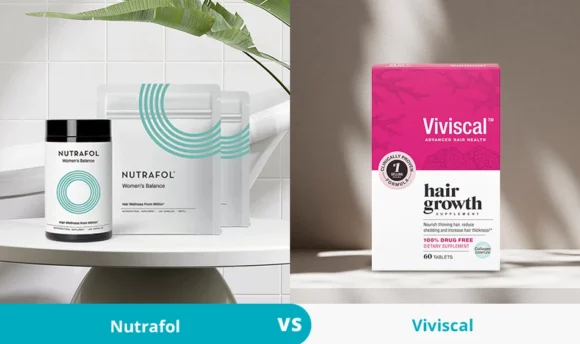Type 1c Hair (Straight): Tips on How to Take Care and Style
Learning which curl pattern category you’re in is important for establishing a good haircare routine. We explain what 1c hair is and recommend the best products for this type.

With such a variety of hair products, techniques, and tools available on the market, it can be overwhelming when you’re trying to select the best ones for you.
Whether you have fine lengths or coarse curls, being able to identify which hair type your mane falls into will make this process much easier and help prevent bad hair days.
If you have straight hair with some volume and thickness, it’s likely that you fall into the type 1c category. As with any other hair type, you’ll run into your fair share of problems that can be solved with a good care and styling routine.
Read on to find out the pros and cons of 1c hair and how to make your locks look and feel great.
What Is 1c Hair Type?
Like others in the type 1 category, 1c hair lies flat at the root and is mainly straight. However, it also features wavy strands through the mid-lengths, with bends in the body and a subtle curl inwards towards the chin.
1c hair tends to be thicker and more voluminous than other types, so it can hold bouncy curls created with styling tools all day and night.
This coarse hair texture means that those in this category often battle with frizz, flyaways, and frazzled ends, as well as tangles and dryness too.
Pros of type 1c hair
If you have 1c hair, you’ll benefit from thicker, more voluminous locks that are easier to style than other hair types. Here are the pros of falling into this curl pattern category:
#1 Holds a curl well
Having a coarse hair type such as 1c helps to hold styles created by heat styling tools much better than 1a or 1b hair.
If you’re hoping to turn your gentle waves into bouncy curls, you can therefore expect them to last throughout the day without too much product.
#2 Resistant to breakage
Unlike other types of type 1 hair, 1c strands have a unique thickness that makes them less prone to breakage.
In contrast to fine and medium hair, thicker strands have an extra deep, spongy layer alongside the cuticle and cortex called the medulla, which helps to maintain moisture and delay the onset of damage.
However, don’t be tempted to ply your hair with heat. Although your locks are generally stronger and hold a curl well, this can still cause damage to the shaft and add to your already frizzy lengths.
#3 Low maintenance
As type 1c falls somewhere between wavy and straight hair, its natural tousled texture gives hair an effortless look that is easy to maintain when you’re short on time.
This means that 1c hair also air drys pretty well, which reduces the need for damaging heat-styling tools such as a blow dryer.
Cons of type 1c hair
Compared to other hair types in the straight category, 1c hair is much more resilient yet still has many of the same concerns. It also has some more unique drawbacks, which can be tackled with a good haircare routine.
#1 Can become frizzy
Due to the dry ends and coarse texture, 1c hair is prone to frizz and often looks poofy throughout the mid-lengths.
Moisture escapes from the shaft in 1c hair while the hair cuticles open to take in moisture from the air instead. This causes the shaft to swell and become frizzy.
#2 Oily scalp
As with the other straight hair types, 1c locks tend to be particularly oily at the roots. This can cause your hair to look greasy and flat, although using light, volumizing products will help to counteract any oiliness.
#3 Dry ends
Although your scalp produces natural oils to keep your hair nourished, the mid-body bends of hair type 1c mean that this moisture struggles to reach its ends.
As a result, the hair tips are likely to feel dry and may therefore require some extra attention when it comes to caring for your tresses.
#4 Tangles easily
Although having thicker strands is beneficial when it comes to styling, the coarse nature of 1c hair can make it prone to tangling. These knots are difficult to brush through and may require some force, which makes your lengths more susceptible to breakage.
How to Take Care of Type 1c Hair
Looking after 1c hair is pretty simple if you know how. Keep reading to discover some dos and don’ts to help you maintain strong, nourished, and healthy locks.
#1 Use a good conditioner
If you’re battling oily roots, you may feel it’s necessary to skip the conditioner. However, it’s important not to skip this step because 1c hair often gets dry at the ends.
You should therefore be sure to apply a lightweight conditioner to your lengths, avoiding the scalp to prevent grease while fighting frizz. Use serums and light leave-in conditioners too, which will moisturize your strands without weighing them down.
#2 Sleep with a silk pillowcase
Those with drier and more voluminous hair are susceptible to knots and tangles, particularly when their head hits the pillow.
Sleeping on a silk or satin pillowcase can minimize the number of tangles that you wake up with, and their softness tends to be pretty comfortable too.
#3 Choose silicone-based products
Although not recommended for 1a and 1b hair types, 1c hair can benefit from a silicone-based serum. Silicones help promote shine, reduce frizz, and prevent heat damage by smoothing raised hair cuticles that cause flyaways.
#4 Don’t overwash hair
Like other straight hair types, 1c hair tends to get pretty greasy pretty quickly at the roots. You may be tempted to wash your hair every day to combat this and prevent any flatness.
However, overwashing can have the opposite effect and strip your scalp of its natural oils, causing the sebaceous glands to ramp up their oil production.
To protect your scalp against greasiness, opt for a hair wash 3–4 times per week at most and use a volumizing dry shampoo to tackle oily roots.
#5 Avoid heat styling tools
This haircare tip can be applied to all categories, but using heat styling tools too frequently can be particularly bad for hair type 1.
The heat from a blow dryer or curler can damage the hair shaft, which alters the texture of strands along with their elasticity. This may also cause hair loss, which can take a while to grow back under unhealthy conditions.
As a result, you may lose that natural wave and find your hair becoming more dry and frizzy. Instead, the best way to dry your hair is with a microfiber towel while avoiding regular cotton ones that will be too abrasive for your delicate strands.
Use a heat protectant if you do decide to create some curls.
#6 Don’t shower with hard water
Hard water contains a variety of metals and minerals, such as calcium and magnesium, that are absorbed by hair fibers. This causes your once soft locks to turn hard and rough, making it difficult to brush your hair.
These hard water metals can also weaken your hair, which increases the probability of breakage. To avoid this, purchase a showerhead that is specifically designed to filter out these chemicals.
Which Hairstyles Are Perfect for Type 1c Hair?
For type 1c hair, it’s generally recommended to keep your lengths as long as possible. The longer the hair, the heavier it will be, which will weigh down the curls and reduce frizz.
However, there are several ways that you can experiment with cuts and styles to add some interest to your straight strands.
#1 Layered cut
Despite having some natural body and waviness, 1c hair still falls into the straight category. Adding some layers will help to increase the volume and movement of your lengths while also giving the hair more texture.
#2 Soft waves
Gentle waves are an ideal option for 1c hair, as this style enables you to enhance your natural texture without the need for too much heat.
Run a texturizing spray through damp hair and scrunch it between your fingers to produce a laid-back, beachy look.
#3 High ponytail
Make the most of your voluminous hair by pulling it into a bouncy high pony. Slicking back your locks will also help to tame those pesky flyaways.
Best Products and Ingredients for 1c Type Hair
When choosing products for a hair type like 1c, try to choose lightweight yet nourishing shampoos and conditioners that won’t add excess oil to your scalp.
You’ll also want to select some moisturizing serums and leave-in products that will help to battle frizz and combat dry ends. Try combining these with a texturizing spray to enhance your natural volume and allow you to rock the air-dried, beachy wave look.
Here are our recommendations for 1c hair products and ingredients:
Ingredients
The best ingredients for 1c hair are ones that enhance your natural volume while reducing frizz and preventing oil or product buildup on the scalp. Look for products containing ingredients such as:
- Argan oil
- Silicones
- Coconut oil
- Almond oil
- Avocado oil
- Jojoba oil
Shampoos and other products
If you’re working with naturally frizzy hair, you’ll want to find a shampoo that helps to moisturize the ends but doesn’t add to greasy roots.
The Moérie Mineral Shampoo is ideal for 1c hair as it contains a range of vitamins, minerals, and proteins to nourish the hair, protect scalp condition, and prevent grease.
Some other products that are great for type 1c hair include:
- Living Proof No Frizz Shampoo
- Moroccanoil Smoothing Conditioner
- Bumble and Bumble Surf Texturizing Finishing Foam
- JVN Complete Hydrating Air Dry Hair Cream
- Kiehl’s Silk Groom Serum
FAQs
You have 1c hair if your locks are mainly straight with some coarse waves throughout. This type is also categorized by dry ends and frizz, as well as a voluminous body.
1c and 2a hair types are often confused due to their similarities. However, 2a hair falls into the wavy hair category and holds an S-shape pattern, whereas 1c is mainly straight with a few loose waves throughout.
Whereas hair type 1a is the rarest category, 1b is the most common, and 1c falls somewhere in between.
A Word From an MD
Type 1c hair can be difficult to identify as its straightness combined with the mid-body bends creates a wavy texture that is often confused with type 2a.
Those with this curl pattern have more volume than others in the hair type 1 category yet suffer from the same oily roots and tangles.
Try to choose products with natural ingredients that aim to minimize frizz and flyaways while locking in moisture to prevent dry ends. Keep your roots clean and residue-free, as this improves the condition of the scalp and helps your hair to grow at a good rate.
Aside from haircare products, to keep your waves healthy, you should try to eat a balanced diet, get regular haircuts, and have scalp massages to boost the flow of blood and nutrients to this area.
Conclusion
1c hair is the most voluminous of the straight hair types as it benefits from a soft, naturally tousled texture and a gentle wave. While it holds a curl well, there’s no need to use much heat as the strands air dry for a beachy look that’s easy to maintain.
Making a few simple tweaks to your haircare routine can help you to get the most from your hair type, such as using a moisturizing serum or conditioner through the ends, sleeping with a silk pillowcase, and avoiding washing your hair too frequently.

















































 Select your language:
Select your language: 








